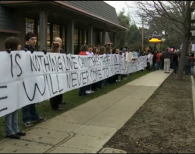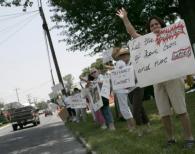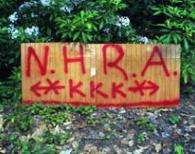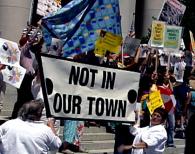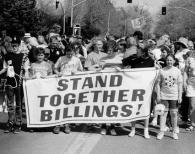"Who is this group that's coming? And I realized ... it's Fred Phelps and my heart just dropped. I can't believe they're coming. Why us? Out of all the schools, why us?" —Daisy Renazco, Gunn High School teacher02/2011—Above is one of NIOT.org's most popular videos, "Gunn High School Sings Away Hate Group," which has garnered more than 225,000 views on our YouTube channel. Ellen DeGeneres, in a Tweet, said she was "so unbelievably proud of Gunn High School in Palo Alto, CA for demonstrating love & acceptance in a peaceful way."What's significant about this video is that it showcases how a community can stand up to hate in a peaceful and constructive way. The video was shot in 2010, when the Kansas hate group known as the Westboro Baptist Church (Fred Phelps' family) announced they would picket Bay Area schools and Jewish institutions. The students of Gunn High School, located in Palo Alto, Calif., decided they could not sit quietly.
When Hate Comes to Your Town
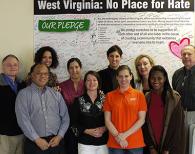
What can a community do when a hate group comes to town and targets a wide variety of organizations, each of which have different ideas of how to respond -- or not?
That's what happened in Charleston and Wheeling, West Virginia in March 2010. The Westboro Baptist Church hate group announced it would picket Jewish and Catholic institutions, a local university, and, as a last-minute addition designed for maximum emotional anguish, the Montcoal Mine, where a dozen miners had just lost their lives.
How could the community respond, particularly when some people preferred to keep a low profile, while others wanted to stage a loud counter-protest? Who could even lead such a community response, given the different values of the targeted groups?
A coalition of local leaders convened at Temple Israel, one of the targeted institutions, and decided they had to present a united front. The message had to be broad enough to include everyone, but specific enough to show opposition to the hatred espoused by Westboro.
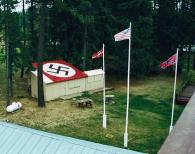
How Ordinary Citizens of Northern Idaho Defeated the Aryan Nations
By Tony Stewart and Norm Gissel, Kootenai County Task Force on Human Relations
In the 1950’s a small group of religious leaders, fed up with Jim Crow racism, started the modern civil rights movement. They demanded that the promises of the Declaration of Independence and the 14th Amendment, declaring equal protection under the law to all citizens, finally be enforced. The vast majority of Americans agreed. What followed was a sea change in the cultural and political life of America. Millions of Americans were recognized for the first time as full members of our great country, and almost overnight, civil rights, formerly a fringe concern, became a mainstream one of most Americans.
But as history has shown us, in a democracy, great cultural and political changes do not occur without a large array of opponents.
